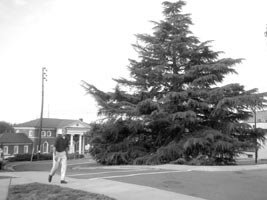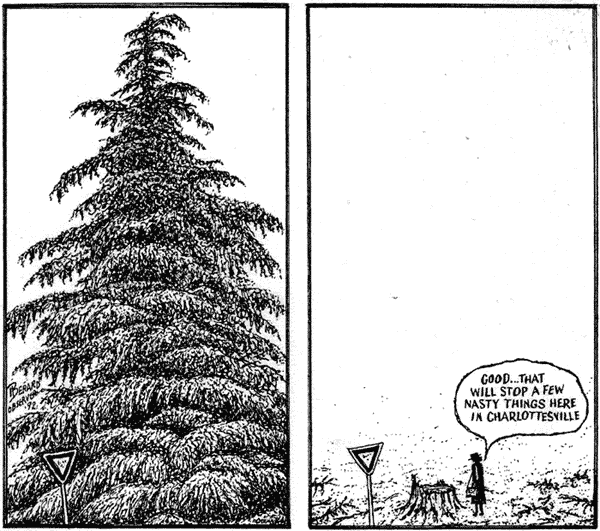Giving tree: Downtown's grandest tree felled
In some ways it was Charlottesville's own "giving tree." Like the famed apple tree in Shel Silverstein's children's book, the massive deodora cedar in front of Charlottesville City Hall was also generous: For 50 years, it provided a year-round touch of green in an increasingly developed cityscape. Like Silverstein's tree, the Charlottesville cedar also gave its life to help the people it served.
On Saturday, November 13, the 50-foot tree was felled to make way for the transit center and new amphitheater under construction at the east end of the Downtown Mall.
Delegate Mitch Van Yahres, founder of the Van Yahres Tree Company, says he's "a little upset" with the way the city has handled the project.
"Originally, when they planned the amphitheater and that center, the tree wasn't considered," he says. "I think expediency dictated the process."
Not only did the city not consider saving the cedar, Van Yahres claims, but it also cut down about 20 smaller trees leading up the hill to Belmont Bridge.
"Those little trees could have been saved," says Van Yahres. "We think of ourselves being so sophisticated, but that was as brutal a thing as could be done."
Van Yahres has a long history with the tree: He planned for the deodora to be planted at the east end of the Mall in the mid-1950s, when he was a twenty-something arborist and the cedar was a 10-foot sapling. The tree, he recalls, was intended to be the city's permanent Christmas tree.
For many years, that was the case, but in the mid-'70s, with the bricking over of Main Street to create the pedestrian Downtown Mall, the City eventually began erecting Christmas trees at Central Place. The cedar by City Hall left the limelight.
The tree made news again briefly in the early 1990s, says Charlottesville Police Sargeant L.A. Durrette, but not for its holiday cheer. Homeless people were taking shelter under the deodora's branches, and contemporary news reports revealed that some community members wanted the tree cut down to help eliminate loitering and disorderly conduct.
"I can't think of a worse reason for cutting a tree down," says Van Yahres.
The deodora earned a reprieve, and Durrette says fear of crime ceased to be an issue there. The City, however, never again used the big tree in yuletide celebrations, though there was at least one year when officials may have wished they had.
In 2000, controversy ensued when the City ponied up $20,000 for a 20-foot fake tree surrounded by plastic lambs and a white picket fence. No sooner was the fake in place under the silhouetted presidents on the City Hall facade than it was destroyed by vandals.
Within hours of the attack, a local donor came forward offering a live replacement, leading some to ask why the City hadn't sought a living tree donation in the first place.
Since then, the City has used a donated tree each year in front of City Hall, says City spokesman Maurice Jones.
"We usually have three or four people call over the summer wanting to give a tree," he says. The city examines each tree on site to determine whether it can be moved easily and whether the size is right for the stand. In general, says Jones, the trees in front of City Hall over the past four years have ranged from 18 to 21 feet. This year, however, because of the construction, the City opted for a 12-footer at Central Place.
Finding and moving a tree is a time consuming– and expensive– venture, even when the tree is donated. So why didn't the city just drape lights on its towering deodora cedar?
"The primary concern was the size," says Jones, who says the city did string lights around the tree in 1999, with little success.
"It didn't look very good," Jones recalls. And, he adds, "Any attempts to really light that tree would have been pretty expensive."
Van Yahres prickles at that claim. "They didn't do a good job," he says of the 1999 lighting attempt. "With any kind of foresight, they would have understood that that tree was not going to stay a little baby all its life– it would have become a big Christmas tree. It would have been quite spectacular by now."
Even if the city couldn't have found a way to preserve the tree in place, Van Yahres says he would have liked to see it relocated.
But Bill Letteri, head of facilities management for the city, deems that impractical.
Letteri estimates the moving cost at $50,000. And then there was possibility that the tree would die anyway.
"The numbers were 10 to 20 percent survival on a tree that large," explains Letteri. "I don't think it's a practical or prudent use of taxpayer dollars."
Again, Van Yahres disagrees. "I don't like the idea of employees making decisions about whether to spend the taxpayers' money. It should have been given over to City Council. There are tree-moving companies that move with a high success rate."
Last month Letteri told the Hook that the tree's only hope of salvation was a private donor. He says that no such donor appeared before the cutting began on November 13.
But even in death, the tree may still serve Charlottesville. "We're exploring the possibility of making some waiting room furniture for the new transit facility," says Letteri. "It's a high quality lumber for building this kind of furniture."
Giving tree, indeed.

Developer Coran Capshaw signed a 40-year lease with the City to enlarge the amphitheater on the east end of the Downtown Mall.
PHOTO BY HAWES SPENCER

The massive deodora cedar was felled on Saturday, November 13.
PHOTO BY HAWES SPENCER

#